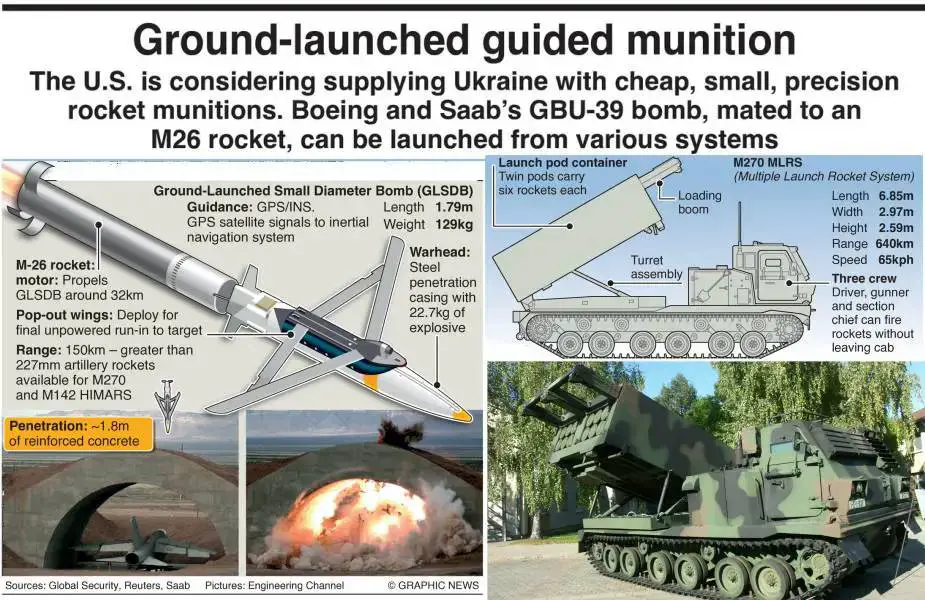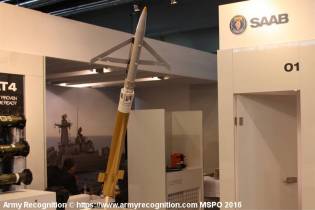- Army
- Air Defense Systems
- Anti-tank systems and vehicles
- Armored Vehicles
- Armoured personnel carriers
- Artillery Vehicles and Weapons
- Command Post
- Communication Vehicles and Systems
- Electronic Warfare
- Engineer | Maintenance Vehicles
- Infantry Fighting Vehicles
- Main Battle Tanks
- Missiles
- Tactical and Logistic Vehicles
- Radars
- Unmanned Systems
- Weapons
- Navy
- Air
GLSDB Ground-Launched Small-Diameter Bomb
GLSDB
Ground-Launched Small-Diameter Bomb - United States / Sweden

Description
The GLSDB (Ground Launched Small Diameter Bomb) is a long-range, precision-guided weapon system developed jointly by the United States and Sweden. It combines the proven capabilities of two existing weapon systems: the GBU-39/B Small Diameter Bomb (SDB) and the M26 rocket motor from the M270 MLRS (Multiple Launch Rocket System). The aim of the GLSDB is to provide ground forces with the ability to engage a wide range of targets at extended ranges while minimizing collateral damage and reducing overall mission costs.
The development of the GLSDB began around 2013 as a joint venture between the United States and Sweden, with American defense contractor Raytheon Technologies and Swedish defense firm Saab working together on the project. The collaboration aimed to provide ground forces with a long-range, precision strike capability that could engage targets with minimal collateral damage.
In 2015, Raytheon and Saab successfully demonstrated the GLSDB's capabilities during a test launch. The system was able to accurately engage and destroy a target at a range of over 150 km (93 miles), showcasing its potential for extended-range ground-based precision strikes.
Since its development, the GLSDB has been of interest to various countries, as it offers a cost-effective, highly accurate, and long-range strike capability that can be employed from existing ground-based platforms. The system has the potential to be used in various scenarios, such as counterinsurgency operations, suppression of enemy air defenses, and the destruction of high-value targets, making it a versatile and valuable asset for modern ground forces.
On January 30,2024, the Digital Newspaper "Politico" announced that the United States will deliver the new Ground-Launched Small Diameter Bomb to Ukraine.
GLSDB Ground-Launched Small-Diameter Bomb variants:
- GLSDB I: The GLSDB I is the initial variant of the weapon and is designed to be launched from the M142 High Mobility Artillery Rocket System (HIMARS) and the M270 Multiple Launch Rocket System (MLRS). The GLSDB I has a maximum range of approximately 70 miles (112 kilometers) and is equipped with a GPS/inertial guidance system, as well as a semi-active laser seeker for terminal guidance.
- GLSDB II: The GLSDB II is a planned variant of the weapon that is being developed to meet emerging operational requirements. The GLSDB II will feature improved range and guidance capabilities and is expected to be compatible with additional launcher platforms, including the Excalibur artillery system.
Technical Data
| Design |
|
The GLSDB has a cylindrical body that is approximately 178 cm long and 18 cm in diameter. The body is made of lightweight materials such as composites, which allow the weapon to be carried and launched by ground-based vehicles. It is fitted with a penetrator warhead designed to penetrate hardened targets. The warhead is typically made of a dense metal, such as tungsten, that can penetrate thick armor and concrete. The bomb has four small control surfaces located near the rear of the weapon. These surfaces allow the weapon to maneuver in flight and make small adjustments to its trajectory as needed. Derived from the M270 MLRS (Multiple Launch Rocket System), the M26 rocket motor is attached to the rear of the GBU-39/B SDB to provide propulsion for ground-based launches.
|
| Warhead |
|
The GLSDB uses the same Small Diameter Bomb (SDB) warhead that is used on the air-launched SDB, which is designed to penetrate hardened targets with a smaller blast radius. The warhead has a mass of around 113 kg and uses a combination of a penetrator and a blast-fragmentation casing to maximize its effectiveness against a range of targets, including hardened structures, light armored vehicles, and personnel. The penetrator is made of a dense metal alloy, such as tungsten, which allows it to penetrate through several feet of reinforced concrete before detonating the explosive charge. The blast-fragmentation casing surrounds the penetrator and contains a high-explosive charge that is designed to create a large blast radius upon detonation. The combination of the penetrator and the blast-fragmentation casing allows the SDB warhead to be effective against a wide range of targets, including those that are heavily armored.
|
| Propulsion |
| The Ground Launched Small Diameter Bomb (GLSDB) uses a rocket motor for propulsion. The rocket motor provides the necessary thrust to accelerate the GLSDB to its target at high speed, allowing it to achieve the necessary range and precision for its intended mission. The rocket motor used in the GLSDB is a solid-fueled motor, which means that it uses a solid propellant to generate thrust. Solid-fueled rocket motors have several advantages over liquid-fueled rocket motors, including simplicity, reliability, and ease of storage. It is designed to provide a specific amount of thrust for a predetermined amount of time, which allows the weapon to achieve the desired range and speed. The rocket motor is also designed to be lightweight and compact, which is important for a ground-launched weapon system where space and weight are at a premium. |
| Guidance System |
| The Ground Launched Small Diameter Bomb (GLSDB) uses a precision guidance system to ensure accurate delivery of the weapon to the intended target. The guidance system consists of several components, including a GPS receiver, an inertial measurement unit (IMU), and a computer processor. The GPS receiver allows the GLSDB to receive location information from orbiting GPS satellites, which provides the weapon with precise location data that is used to navigate to its target. The IMU measures the weapon's acceleration and rotation to determine its position and orientation in three-dimensional space. The computer processor then uses the data from the GPS receiver and IMU to calculate the weapon's current position, speed, and direction, and make any necessary adjustments to its flight path. In addition to the GPS and IMU, the GLSDB also uses a semi-active laser seeker for terminal guidance. The laser seeker allows the weapon to "paint" the target with a laser beam, which is then detected by the weapon's seeker. The weapon then adjusts its flight path to guide itself to the laser point, ensuring accurate delivery of the warhead to the intended target. The bomb is also equipped with an Inertial Navigation System (INS) that allows it to navigate to its target with a high degree of accuracy. The INS is used in combination with other guidance systems, such as GPS and laser guidance, to provide the necessary navigational data for the weapon. The INS uses a set of accelerometers and gyroscopes to measure the weapon's acceleration and rotation, allowing it to determine its position and orientation in three-dimensional space. This information is used to calculate the weapon's flight path and trajectory, enabling it to reach its target with a high degree of accuracy. |
| Combat Use |
| The Ground Launched Small Diameter Bomb (GLSDB) can be launched from a variety of ground-based launcher systems, depending on the specific mission requirements. These launcher systems are designed to provide a stable platform for the weapon during launch, ensuring accuracy and reliability. One of the most commonly used GLSDB launcher systems is the M142 High Mobility Artillery Rocket System (HIMARS). The HIMARS is a mobile artillery system that can be rapidly deployed to a variety of locations, allowing the GLSDB to be launched from a position of advantage. The HIMARS launcher is capable of carrying up to six GLSDBs at a time, providing a high volume of fire when needed. Another common GLSDB launcher system is the M270 Multiple Launch Rocket System (MLRS). The MLRS is a larger launcher system that is capable of carrying up to two GLSDBs per launch pod. The MLRS launcher system is typically employed in larger-scale operations, where multiple targets need to be engaged simultaneously. In addition to the HIMARS and MLRS, the GLSDB can also be launched from a truck-mounted launcher system or a static launch platform. These launcher systems are typically employed in more static environments, such as defensive positions or fortified positions. The range of the GLSDB depends on a variety of factors, including the specific launch platform, altitude of launch, and mission requirements. However, the GLSDB is designed to have a maximum range of approximately 112 km when launched from a high-altitude platform, such as the M270 Multiple Launch Rocket System (MLRS). When launched from a lower altitude platform, such as the M142 High Mobility Artillery Rocket System (HIMARS), the range of the GLSDB may be somewhat shorter, typically in the range of 64-96 km. However, the range of the GLSDB can be increased by employing a lofted trajectory, which allows the weapon to travel further while remaining within a safe operational envelope. The bomb is designed to achieve a high degree of accuracy, with a CEP (Circular Error Probable) of less than 10 meters The Ground Launched Small Diameter Bomb (GLSDB) is designed to engage a wide range of targets, including those that are heavily fortified or hardened. The GLSDB's high-density penetrator and blast-fragmentation casing make it an effective weapon against command and control centers, which are often located in hardened structures. It can be also used to engage enemy air defense systems, such as surface-to-air missile sites, radar installations, and anti-aircraft artillery. The GLSDB is effective against light armored vehicles, such as trucks, jeeps, armored personnel carriers, and can be also used to engage enemy personnel in the open or in fortified positions, including bunkers and trenches. The bomb is also effective against hardened facilities, such as underground bunkers and storage depots. |
Specifications
| Type | Range |
| Precision-guided munition that can be launched by MLRS Multiple Launch Rockey System | Launched by M270 MLRS: 113 km Launched by M142 HIMARS: 70 km |
| Country users | Weight |
| United States | 270 kg |
| Designer Country | Speed |
| United States | Up to Mach 5 |
| Type of warheads | Altitude |
| Penetrating warhead | Maximum altitude of approximately 150 km |
| Accuracy | Dimensions |
| Less than 1 m | Length: 3.91 m; Diameter: 17.8 cm; Wingspan: 1.61 m |
Details View
 |
|
 |
 |
Pictures - Video



























